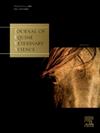母马宫内输注子宫消毒液的临床安全性。
IF 1.6
3区 农林科学
Q2 VETERINARY SCIENCES
引用次数: 0
摘要
背景:对常规治疗的有限反应和不断上升的抗生素耐药性强调了感染性子宫内膜炎替代治疗的必要性。最近的一项体外研究表明,一种商业子宫清洁消毒剂(UCS)对子宫内膜炎病原体具有良好的抗菌活性。然而,它在母马身上的安全性和有效性尚未得到检验。目的:本研究旨在评估生殖健全母马宫内输注UCS的临床安全性。方法:实验1。6匹子宫内膜活检分类为I或IIA的健康母马在发情期间两次宫内输注UCS。治疗后3天、排卵后8天和21天分别行活检。Exp。2。11匹生殖健全的母马有两个发情周期,在发情开始时随机分配两次宫内输注UCS或安慰剂(乳酸林格)。末次给药后24h进行人工授精。排卵后8天进行胚胎冲洗。结果:实验1。子宫内膜活检评分略有变化,主要是由于子宫内膜炎症浸润增加,治疗后3天,排卵后8天和21天完全恢复到基线。Exp。2。胚胎恢复率在UCS(9/11)和安慰剂(8/11)周期之间相似。结论:综上所述,子宫内灌注UCS是一种安全的治疗方法,可能是治疗母马子宫内膜炎的一种有前景的辅助治疗方法。本文章由计算机程序翻译,如有差异,请以英文原文为准。
Clinical safety of intrauterine infusion of a uterine sanitizer in mares
Background
Limited response to conventional therapies and rising antibiotic resistance emphasize the need for alternative treatments for infectious endometritis. A recent in vitro study showed promising antimicrobial activity of a commercial uterine cleaning sanitizer (UCS) against endometritis pathogens. However, its safety and efficacy in mares remain untested.
Aims/objectives
This study aimed to assess the clinical safety of intrauterine infusion of UCS in reproductively sound mares.
Methods
Exp. 1. Six healthy mares with endometrial biopsies classified as I or IIA had two intrauterine infusions of UCS performed during estrus. Biopsies were taken 3 days post-treatment and 8- and 21-days post-ovulation. Exp. 2. Eleven reproductive sound mares had two estrous cycles randomly assigned to receive two intrauterine infusions of UCS or placebo (lactate ringer) at the beginning of estrus. Mares were inseminated 24 h after the last treatment. Embryo flushing was performed 8 days post-ovulation.
Results
Exp. 1. There was a slight change in endometrial biopsy scores, primarily due to an increased inflammatory infiltrate in the endometrium, three days post-treatment with complete recovery to baselines at 8- and 21-days post-ovulation. Exp. 2. Embryo recovery rates were similar between UCS (9/11) and placebo (8/11) cycles.
Conclusion
In conclusion, intrauterine infusion of UCS appears to be a safe therapy in broodmare practice and may offer a promising adjuvant therapy for endometritis in mares.
求助全文
通过发布文献求助,成功后即可免费获取论文全文。
去求助
来源期刊

Journal of Equine Veterinary Science
农林科学-兽医学
CiteScore
2.70
自引率
7.70%
发文量
249
审稿时长
77 days
期刊介绍:
Journal of Equine Veterinary Science (JEVS) is an international publication designed for the practicing equine veterinarian, equine researcher, and other equine health care specialist. Published monthly, each issue of JEVS includes original research, reviews, case reports, short communications, and clinical techniques from leaders in the equine veterinary field, covering such topics as laminitis, reproduction, infectious disease, parasitology, behavior, podology, internal medicine, surgery and nutrition.
 求助内容:
求助内容: 应助结果提醒方式:
应助结果提醒方式:


